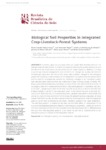Use este identificador para citar ou linkar para este item:
http://www.alice.cnptia.embrapa.br/alice/handle/doc/1070968Registro completo de metadados
| Campo DC | Valor | Idioma |
|---|---|---|
| dc.contributor.author | ASSIS, P. C. R. | pt_BR |
| dc.contributor.author | STONE, L. F. | pt_BR |
| dc.contributor.author | SILVEIRA, A. L. R. da | pt_BR |
| dc.contributor.author | OLIVEIRA, J. de M. | pt_BR |
| dc.contributor.author | WRUCK, F. J. | pt_BR |
| dc.contributor.author | MADARI, B. E. | pt_BR |
| dc.date.accessioned | 2017-06-14T11:11:11Z | pt_BR |
| dc.date.available | 2017-06-14T11:11:11Z | pt_BR |
| dc.date.created | 2017-06-14 | pt_BR |
| dc.date.issued | 2017 | pt_BR |
| dc.identifier.citation | Revista Brasileira de Ciência do Solo, v. 41, e0160209, 2017. | pt_BR |
| dc.identifier.uri | http://www.alice.cnptia.embrapa.br/alice/handle/doc/1070968 | pt_BR |
| dc.description | Currently, agricultural productivity and sustainable development are the desired bases for the creation of production systems. Farming for greater production and the efficient use of soil resources are at the core of modern systems. However, the way in which agricultural management and practices can change soil quality has become increasingly important. The aim of this study was to detect changes in soil biological properties caused by implementation of the integrated crop-livestock-forest system (iCLF) and to identify the properties suitable for detecting changes in soil biological quality. Soil samples were collected from the 0.00-0.10 m layer in Nova Canaã do Norte, MT, Brazil, and Cachoeira Dourada, GO, Brazil, in areas of the iCLF with 1 (iCLF1) or 3 (iCLF3) eucalyptus rows and in areas of recovered and degraded pasture. In Cachoeira Dourada, in the iCLF1, samples were taken in the tree row and at 2.5, 5.0, and 10.0 m from this row. In Nova Canaã in the iCLF3, samples were taken in the center row and at 3.0, 6.0, 9.0, and 12.0 m from this row. In Cachoeira Dourada, samples were taken in the center row and at 1.5, 3.0, 4.5, 6.0, and 9.0 m from this row. All samples had five replicates. In Nova Canaã, the iCLF1 caused less disturbance in the microbial population than the degraded pasture, which was evidenced by the lower metabolic quotient and basal respiration. The sampling position in relation to the tree row had little effect on comparison of the iCLF with the degraded pasture in regard to soil biological properties. Carbon and N of the microbial biomass and the microbial quotient were the best properties for differentiating the iCLF from the degraded pasture. ICLFs have not yet led to improvements in soil biological quality in relation to the degraded pasture. | pt_BR |
| dc.language.iso | eng | eng |
| dc.rights | openAccess | eng |
| dc.subject | Integração lavoura-pecuária-floresta | pt_BR |
| dc.title | Biological soil properties in integrated crop-livestock-forest systems. | pt_BR |
| dc.type | Artigo de periódico | pt_BR |
| dc.date.updated | 2017-06-20T11:11:11Z | pt_BR |
| dc.subject.thesagro | Solo | pt_BR |
| dc.subject.thesagro | Manejo do solo | pt_BR |
| dc.subject.thesagro | Deterioração do solo | pt_BR |
| dc.subject.thesagro | Propriedade físico-química | pt_BR |
| dc.subject.nalthesaurus | Soil properties | pt_BR |
| riaa.ainfo.id | 1070968 | pt_BR |
| riaa.ainfo.lastupdate | 2017-06-20 | pt_BR |
| dc.identifier.doi | 10.1590/18069657rbcs20160209 | pt_BR |
| dc.contributor.institution | PAULA CAMYLLA RAMOS ASSIS; LUIS FERNANDO STONE, CNPAF; ANDRE LUIS RODRIGUES DA SILVEIRA; JANAINA DE MOURA OLIVEIRA; FLAVIO JESUS WRUCK, CPAMT; BEATA EMOKE MADARI, CNPAF. | pt_BR |
| Aparece nas coleções: | Artigo em periódico indexado (CNPAF)  | |
Arquivos associados a este item:
| Arquivo | Descrição | Tamanho | Formato | |
|---|---|---|---|---|
| CNPAF2017rbcs.pdf | 720,19 kB | Adobe PDF |  Visualizar/Abrir |









